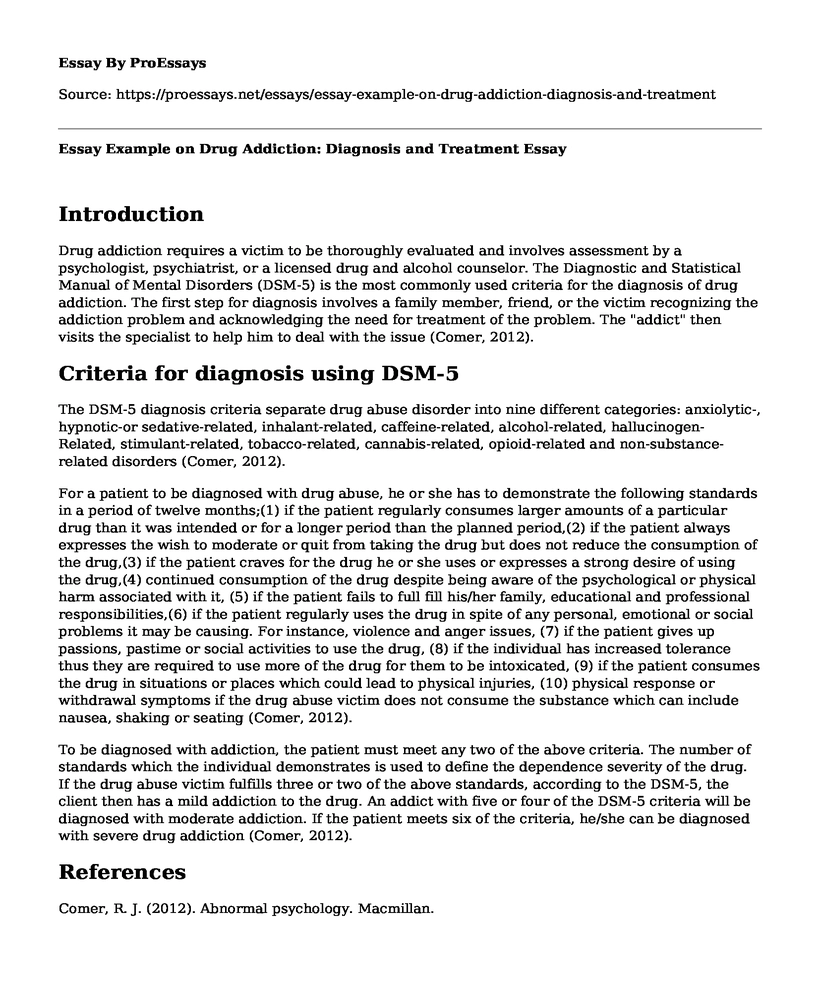Introduction
Drug addiction requires a victim to be thoroughly evaluated and involves assessment by a psychologist, psychiatrist, or a licensed drug and alcohol counselor. The Diagnostic and Statistical Manual of Mental Disorders (DSM-5) is the most commonly used criteria for the diagnosis of drug addiction. The first step for diagnosis involves a family member, friend, or the victim recognizing the addiction problem and acknowledging the need for treatment of the problem. The "addict" then visits the specialist to help him to deal with the issue (Comer, 2012).
Criteria for diagnosis using DSM-5
The DSM-5 diagnosis criteria separate drug abuse disorder into nine different categories: anxiolytic-, hypnotic-or sedative-related, inhalant-related, caffeine-related, alcohol-related, hallucinogen-Related, stimulant-related, tobacco-related, cannabis-related, opioid-related and non-substance-related disorders (Comer, 2012).
For a patient to be diagnosed with drug abuse, he or she has to demonstrate the following standards in a period of twelve months;(1) if the patient regularly consumes larger amounts of a particular drug than it was intended or for a longer period than the planned period,(2) if the patient always expresses the wish to moderate or quit from taking the drug but does not reduce the consumption of the drug,(3) if the patient craves for the drug he or she uses or expresses a strong desire of using the drug,(4) continued consumption of the drug despite being aware of the psychological or physical harm associated with it, (5) if the patient fails to full fill his/her family, educational and professional responsibilities,(6) if the patient regularly uses the drug in spite of any personal, emotional or social problems it may be causing. For instance, violence and anger issues, (7) if the patient gives up passions, pastime or social activities to use the drug, (8) if the individual has increased tolerance thus they are required to use more of the drug for them to be intoxicated, (9) if the patient consumes the drug in situations or places which could lead to physical injuries, (10) physical response or withdrawal symptoms if the drug abuse victim does not consume the substance which can include nausea, shaking or seating (Comer, 2012).
To be diagnosed with addiction, the patient must meet any two of the above criteria. The number of standards which the individual demonstrates is used to define the dependence severity of the drug. If the drug abuse victim fulfills three or two of the above standards, according to the DSM-5, the client then has a mild addiction to the drug. An addict with five or four of the DSM-5 criteria will be diagnosed with moderate addiction. If the patient meets six of the criteria, he/she can be diagnosed with severe drug addiction (Comer, 2012).
References
Comer, R. J. (2012). Abnormal psychology. Macmillan.
Cite this page
Essay Example on Drug Addiction: Diagnosis and Treatment. (2023, Jan 26). Retrieved from https://proessays.net/essays/essay-example-on-drug-addiction-diagnosis-and-treatment
If you are the original author of this essay and no longer wish to have it published on the ProEssays website, please click below to request its removal:
- Course Work Example on Children's Nutrition
- Research Paper on Thyroid Cancer
- Assignment Example on Idea of a Healthy Community
- Essay Sample on Modern Terrorism
- Essay on Savannah's Struggles: A Tale of Chronic Disease, Poverty & Alienation
- 9/11: How It Changed America Forever - Essay Sample
- Essay Example on Exploring My Interest in Health-Related Fields: A Journey of Self-Discovery







